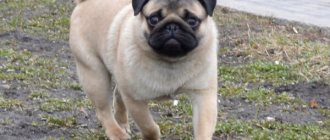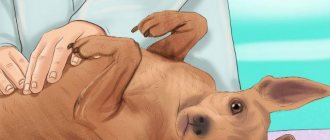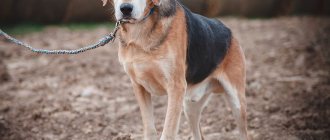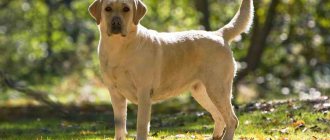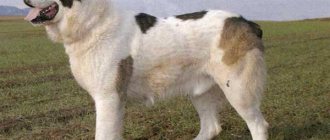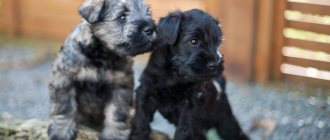The dachshund is often called the best burrow hunter in the world. After all, this breed was bred specifically for this.
Dachshunds are believed to have English, German and French blood.
The lifespan of a dog is up to 15 years, weight is 5-9 kg, height at the withers is 22-27 cm.
The dachshund is a cheerful, wayward and loyal animal that will become your true friend.
These dogs are easy to care for, but they still have some features that you need to know.
Discopathy - what is it?
Discopathy is one of the most common diseases among dachshunds.
The disease is characterized by loss of elasticity of the intervertebral discs. At the same time, some discs become thinner, crushed and are unable to perform their shock-absorbing functions. A process reminiscent of premature aging occurs in the Dachshund's spine.
NOTE!
The predisposition to discopathy is inherent in dachshunds at the genetic level. This is why a healthy pet can develop discopathy for no apparent reason.
Causes
There are several causes of discopathy in dachshunds, these are:
- Genetic predisposition . The reason is a mutation of certain genes, as a result of which the growth process of the vertebrae changes and the spinal canal narrows. In this case, the disease develops in dogs at a young age.
- Special body structure (elongated spine and short legs).
- Age-related changes . Most often, dogs that have reached 4-9 years of age suffer from this disease, even if the pet was absolutely healthy before that.
- Sedentary lifestyle . It was noticed that in dogs constantly engaged in burrow hunting, discopathy occurs much less frequently than in dachshunds leading a “domestic” lifestyle.
- Obesity . Body weight puts pressure on the vertebrae, causing them to experience additional stress and wear out faster.
- Excessive physical activity often contributes to rapid wear of the spinal discs.
Disease: clinical characteristics, stages
Discopathy in a dachshund is a disease of intervertebral discs (hernia), which lose their mobility, plasticity, and ability to perform shock-absorbing functions. In other words, it ceases to be a spring in the body. The term can be defined as a degenerative disease of the spinal motion segment. The process of rapid aging begins in the spinal cord of the dachshund. Acts on: spinal cord, circulatory system, nerve endings. The dog is genetically predisposed to the disease, so it can start without good reason. Most often, the hind limbs are paralyzed - with a pelvic disease, or all four legs fail - with cervical discopathy. This happens completely suddenly. The following stages of the disease are distinguished:
- First stage. The pupil moves less and does not jump. If you touch the back or spine, the dog will feel pain and react accordingly.
- The hind legs sway when walking and the dachshund does not obey.
- The hind legs are taken away, but sensitivity is present in them. The paralysis is not complete. But after forty-eight hours, an irreversible reaction for the spinal cord may begin.
- In fact, complete paralysis of the paws, there is practically no sensitivity. The limbs are just dangling.
- Doesn't respond to pain. Motor and sensory mechanisms are impaired.
- The spinal cord dies. Cannot be treated.
Symptoms of the disease
At the initial stages, discopathy in dachshunds is asymptomatic and often goes unnoticed. Only when the dog begins to experience pain and worry do they pay attention to the problem.
But, there are a number of symptoms that can help identify discopathy in the early stages:
- The pet behaves restlessly, cannot lie down, find a place or the right position.
- The dog becomes sad, depressed, and does not jump for joy.
- The dachshund refuses to go up and down stairs, climb to high places, or make any physical effort.
- A hunched back and tense abdomen in a dachshund can indicate both discopathy and other diseases of the musculoskeletal system.
- Shuffling, limping, change in gait, decreased sensitivity in paws.
- Paralysis of limbs.
- Uncontrolled urination and defecation.
Expert opinion
Tolkachev Andrey Mikhailovich
veterinarian
Don't wait until your dog becomes paralyzed, because it is not difficult to detect discopathy in the early stages. To do this, you just need to be attentive to your pet and regularly show it to the veterinarian. Another important point is that if your dog is diagnosed with discopathy, you should not allow it to breed, this way you can reduce the number of animals genetically predisposed to the disease.
Discopathy in a dachshund
The dachshund, as a breed, occupies a special place in the practice of a veterinary neurologist. This feature is due to the fact that dachshunds, like some other breeds, have a breed predisposition to the development of discopathy. You can read more about the essence of discopathy and its types in this article.
The fact is that the dachshund combines a predisposition to the development of discopathy and the popularity of the breed, which makes it a leader among neurological visitors to the veterinarian. In dachshunds, even before the age of one year, the pathological process of replacing disc structures with chondroid tissue begins, constituting the essence of the process of chondroid metaplasia. Chondroid tissue, not having the elasticity and shock-absorbing properties of its predecessor tissue, tends to exit through the torn fibrous ring into the spinal cord canal, causing irritation, swelling with the subsequent development of pain and neurological deficit.
Typically, this period of degeneration of disc tissue lasts 3.5-4 years from the birth of the dachshund. In our practice, we have not encountered discopathy in dachshunds before the age of 3.5 years. Thus, it is likely that all or most dachshunds by the age of 4 already have all the conditions for the development of discopathy or intervertebral hernia, to put it more clearly. In dachshunds, hernias in most cases occur according to the development scenario of extrusions (more details about the differences between extrusions and protrusions, as a particular situation of discopathy) can be read at the link above.
Many small hernias in dachshunds, like other breeds, go unnoticed, since the owner can only notice the obvious clinical picture of discopathy in the form of pain or poor gait. Disc herniations, including those in Dachshunds, are the most common cause of acute pain in Dachshunds. And thus, a dog can live its entire life with a subclinical course of the pathology, that is, with compensated extrusion.
There is anecdotal evidence that among dachshunds that regularly engage in burrowing and other activities, hernias occur less frequently. This idea is quite fair if you understand that the development of discopathy in a dachshund is most likely associated with impaired blood circulation in the area of the vascular system of the intervertebral disc. Activity will improve blood circulation, and therefore slow down the development of degeneration of disc contents and, accordingly, the development of discopathy. In this case, we are talking about activity from early puppyhood; the activity of a dachshund that already has signs of discopathy is unlikely to improve the condition of the disc, but rather accelerate the development of extrusion.
Here is a clinical example of the condition of a Dachshund's spine on an MRI. The arrows indicate discs that do not accumulate the contrast agent, since impaired blood circulation does not allow this to happen. It can be assumed that the darker the disc on an MRI with contrast, the more pronounced the destructive processes in it. In this picture, the spine of a dachshund has already developed a small hernia
Another aspect that makes the Dachshund unique among breeds prone to developing discopathy is its body shape. Many owners, and even doctors, think that it is the long and disproportionate shape of the body that creates the problem of discopathy. Actually this is not true. The length of the body (and the length of the body is related to the length of the vertebra, since the body cannot become longer without lengthening the anatomical structures of this very body) contributes to more pronounced mechanical pressure on the disc when the spine bends; simply put, the leverage or leverage on the intervertebral space increases . Thus, the previously destroyed disc, under pressure, collapses and the spinal canal emerges, initiating the entire clinical manifestation of discopathy in the form of pain and paralysis (paresis).
These are the features of the development of discopathy with subsequent hernias in dachshunds.
Similar articles
- Protrusions in the cervical spine of a dachshund. On this MRI section, one can note the three most pronounced compression of the spinal cord by displaced intervertebral discs in the cervical spine (C2-C3,…
- Discopathy in dogs (extrusion and protrusion) Discopathy is a collective term that is used exclusively in veterinary medicine and characterizes all pathologies of intervertebral discs in dogs and, less often, in…
Diagnostic methods
In modern veterinary medicine, there are several methods for diagnosing discopathy:
- Visual inspection . At the same time, the veterinarian evaluates the dog’s skills: walking, jumping, reflex speed, presence of pain, etc.
- If the dog partially or completely lacks sensitivity in the limbs, the doctor assesses the time of onset of paralysis . It is believed that if more than 12 hours have passed since the moment of immobility, then it is no longer possible to restore the function of bowel movements, since it is impossible to restore the function of neurons.
- X-ray studies . In this case, an x-ray allows you to detect changes in the spine, exclude diseases of the vertebrae, and also allows you to detect the presence of injuries.
- MRI (magnetic resonance imaging) allows you to see an accurate and complete picture of the condition of the dog’s spine. The study is done layer by layer in a three-dimensional projection, which makes it possible to understand the picture of the disease as a whole. During the MRI, the animal is under the influence of sedatives.
- Myelography is a research method in which a contrast agent is injected under the arachnoid membrane of the dog's spinal cord, and then an X-ray examination is performed.
General treatment regimen
After the examination is completed, the veterinarian makes a decision on treatment methods.
At the appointed time, the dog is given general anesthesia and the operation begins. During the damage operation, the disc is removed. If necessary, the doctor opens the dura mater of the spinal cord to reduce pressure on it and improve its conductivity and metabolic processes occurring in it.
After the operation, the animal undergoes a rehabilitation process, during which it is prescribed painkillers, anti-inflammatory drugs, and antibiotics.
After the rehabilitation period, the dog is prescribed physiotherapeutic procedures, as well as vitamins. All this will allow the pet to return to its normal lifestyle.
IMPORTANT!
Even after successful removal of the damaged disc, relapses are possible in dachshunds.
Treatment of discopathy and prognosis
It is important to discuss with your veterinarian how to treat discopathy in your pet. Usually, in the first stages, constant wearing of a corset and drug treatment are recommended: anti-inflammatory drugs and hormones. This treatment will reduce pain and alleviate the condition of the dachshund.
At stages 1 and 2, the use of a corset is effective, limiting the movement of the dachshund.
At later stages, starting from 3-4, surgery is expected on the dachshund. There is no need to be afraid of this - after all, if the operation is late, the dog’s mobility will never return. Afterwards the dachshund will put on the corset again for better recovery.
Drug treatment
At the initial stage of the disease, drug treatment is allowed, which helps relieve symptoms, but does not cure the disease.
For conservative treatment of discoptia, the veterinarian prescribes:
- Corticosteroid hormones.
- Vitamin "B" injections.
- Non-steroidal anti-inflammatory drugs such as Rimadyl, Previcox, Ketofen.
- Painkillers.
- Chondroprotectors to maintain cartilage structure, such as Flexan. Such substances contain bioactive collagen molecules, which slow down degenerative processes in the spine.
- Drugs that relieve inflammation, for example, Canina Petvital Frnhro tabletttn. Such drugs help to establish balance in the inert tissue and increase the elasticity of the ligaments, which bear additional stress due to the loss of functionality of the spinal disc.
Surgical intervention
The choice of technique is made by the doctor depending on which part of the spine is affected.
Surgical methods for treating discopathy in dachshunds:
- Ventral slits method . With this technique, the doctor drills a small window between two vertebrae at the level where the affected disc is located. After this, either part of the disk or the entire disk is removed. The technique is used for disc pathologies in the cervical spine.
- Hemilaminectomy . With this technique, access to the spine is through the processes of the joints. The method is used for disc pathology in the thoracic or lumbar region.
- Dorsal laminectomy . In this case, access to the spine is carried out from above due to the fact that the vertebral arch is removed.
Disease prevention
Discopathy is divided into 6 stages, depending on how severe the neurological symptoms are:
- An inattentive owner may not notice stage 1. The animal will reduce its normal range of motion and will avoid jumping. If you try to feel the spine, you will find a painful area - the dachshund will yelp and will not allow itself to be touched in this place.
- Stage 2 differs from the first stage by the swaying of the dachshund’s legs. The animal runs less and less, but if it goes for a walk, you will notice the following: the walking is slow, and the hind legs seem to be poorly obeying the dog, swaying. Discopathy in dachshunds is divided into 6 stages.
- Stage 3 is quite bright. It is at this time that people most often seek veterinary help. The dog loses the ability to lean on its hind legs and only pulls them behind itself. Sensitivity is preserved at this time, which can be checked by pinching the dachshund's paw. Some movements of the limbs are still preserved, there is no complete paralysis.
- Stage 4 means dachshund paralysis. The paws are absolutely motionless, there are no voluntary movements. You can achieve movement of the paw only in response to severe pain - this will be a reflex jerk, which means that sensitivity is still there, but only very deep.
- Stage 5 occurs when the dog stops responding to severe pain. This will mean severe compression of the spinal cord, in which both motor and sensory fibers are damaged.
- Stage 6 is determined during surgery. With it, the spinal cord dies - it softens and can never perform its functions again. Recovery at the sixth stage is impossible.
At stages 1 and 2, the use of a corset is effective, limiting the movement of the dachshund. The corset is made of thick fabric with metal inserts. It will reduce the movements of the dachshund, will fix the spine and support it.
Due to this, the progress of the disease will stop, and the dog’s condition will not worsen. If you catch the disease at the right time, the corset, in combination with drug treatment, will improve the dog’s well-being, eliminate pain and restore mobility.
We suggest you read: What food to feed your British cat
The charm of a dachshund cannot be replaced by any other animal, therefore, despite genetic health problems, there is no need to deny yourself the purchase of a pet. But be sure to check whether the puppy’s parents have any symptoms of hereditary discopathy. Experienced breeders try to exclude sick dogs from breeding.
To maintain your pet’s health, you need to remember that the dachshund has a special body shape for a reason; it is its dignity. The exceptional qualities of the dachshund as a burrow hunter are precisely due to its interesting body.
If you have a summer house, provide your dog with a place on the property where he can dig holes and thereby strengthen his back muscles.
The bulky, lightweight dachshunds allow it to hold its breath underground for a long time, and its greater mobility plays a role in defeating a predator even in cramped burrow conditions. Therefore, it is good if you build an artificial hole on your property in which the dachshund will train its back muscles.
It is extremely rare that symptoms of discopathy can be found in a dog that is actively involved in burrow hunting. Such dachshunds have a developed muscular frame of the back, which supports the spine.
Following these simple rules will keep your dachshund healthy and give you many years of living with an active and cheerful pet.
We invite you to watch a video in which a veterinarian talks about discopathy in dachshunds, the symptoms of this disease and methods of treatment.
Preventive measures
Methods for preventing discopathy in dachshunds:
- Moderate physical activity is an excellent prevention of excess weight.
- Under no circumstances should you pick up a dachshund under your arm. You can only lift a dog by placing one hand under its front legs and the other under its hind legs.
- Don't let your dachshund jump on or off the couch.
- Carefully monitor your pet's diet and do not overfeed it.
- Be sure to give your dog vitamins and special supplements rich in microelements and nutrients.
- Swimming, massage, jogging must be present in a dog’s life.
Reasons for the development of the disease
Unlike humans, osteochondrosis is more common in young dogs. This is due to the peculiarities of the development of their musculoskeletal system and connective tissue.
The causes of pathology include the following factors:
- trauma and inflammation;
- obesity;
- infections;
- gastrointestinal diseases that disrupt metabolism;
- cardiovascular diseases;
- poor environmental conditions;
- improper or poor quality nutrition (nutrient deficiencies and surpluses);
- excessive physical activity;
- autoimmune disorders and congenital anomalies characteristic of inbreeding;
- frequent hypothermia.
Approximately 80% of cases occur in male dogs. This means that the disease has a gender predisposition. It is also important to note the effect of too rapid growth of bone tissue, which is typical for animals with large dimensions.



